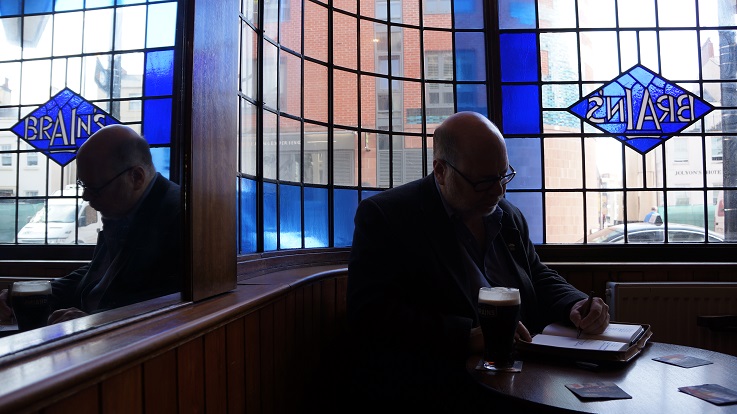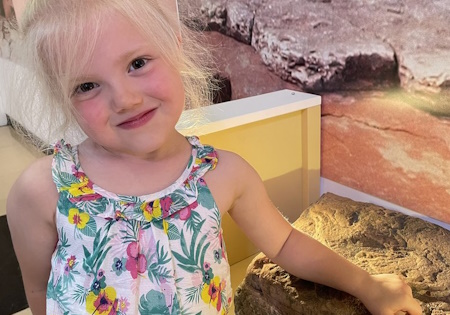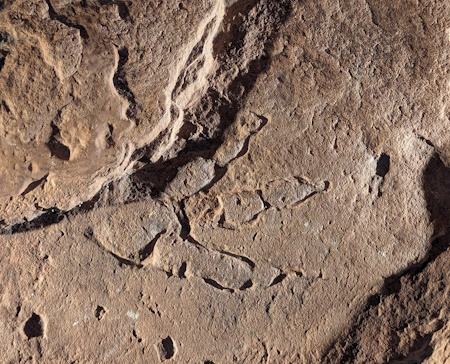 |
It was a time, not geologically very long ago, when I was a child. It was a time before pterodactyls were thought to fly, could only glide, when the Brontosaurus dragged its tail, that dinosaurs were coldblooded and without feathers, and it was believed they were extinct despite the wrens in Bute Park and the swans on the River Taff. I was a childhood admirer of Roy Chapman Andrews. In the 1910s and 20s, he repeatedly led teams across China and into the Gobi Desert of Mongolia, armed against bandits. On 13th July 1923, his team made the first discovery of dinosaur eggs. Many times, I read his account and wanted to emulate him.
Here I must insert an important side note. It was a Catholic Priest, Jean-Jacques Pouech, a naturalist in his spare moments, who found the first dinosaur eggshell fragments in 1859 - in France! He determined them to be four times the volume of an ostrich egg. This brilliant man at first thought them to be reptilian, but on closer examination, he realized they had the features of bird eggs - from a rather large bird! It proved a prophetic analysis. When the fossil was reviewed in 1989, it was established to be from a dinosaur. One does not have to travel halfway around the world to Mongolia to make dinosaur discoveries.
Dinosaur aficionado Lily Wilder, whose favorite dinosaur is T-Rex, was all of four years old when, in January of 2021, she found the footprint of a small three-toed bipedal theropod on the rocky beach of The Bendricks near Barry. It was placed there 220 million years ago by an early dinosaur about 30 inches tall and eight feet long. It was the late Triassic period in the long reign of dinosaurs, which lasted 165 million years before the bulk of them went extinct. Learning this story, the dormant child in me began to boil with jealousy.

Lily Wilder
I took the train to Cadoxton Station near Barry. From there I made my way to The Bendricks by bus and foot toting a camera. As an amateur photographer, I knew to go late in the day knowing the raking sunlight would extend shadows and make shallow footprints more visible. It was a beautiful day given by the powerful sun. There were folks fishing. Younger people were picnicking on the rocks to loud music. They were all watching the floating traffic on the Bristol Channel. I dressed wrong and was too hot, but it was an interesting day and served up lesser rewards. A waxing gibbous moon was in the sky pulling up the tide. I had not taken the moon into account.
Walking the crumbling beach between Barry and Sully proved very difficult. There was a time when I would have leaped and climbed and raced across the irregular rocks without fear. In the last half-dozen years that ability has dissipated. I shuffled and clambered. What was once easy and simple, felt dangerous to attempt. I often abandoned the beach for the Wales Coast Path which runs alongside. To quote the Geological Society of London, ďBendrick Rock in Barry, South Glamorgan is one of the UK's most important coastal geological localities and is listed as both a Site of Special Scientific Interest (SSSI) and a Geological Conservation Review Site (GCR). The GCR lists the locality twice, for its stratigraphy and for its exceptional fossil reptile tracks.Ē I didnít find any dinosaur tracks.
Maybe they were beneath the rising water, or maybe I did see them, but didnít recognize them for what they were, vague or filled with silt. Every pockmark across the rocks could have been a footprint. I asked the locals fishing and picnicking. Most had a vague notion that tracks were somewhere around there. The young people didnít know at all.
A failure to be sure, but still it was inspiring.
The ground rises and falls and drifts and folds. It happens too slowly for us to see. Time turns the layers of rock and we get to page through prehistory. I remembered seeing books burn a page at a time. Along the southwest coast of Wales, as the cliffs crumble and the sea eats away the shoreline, a page is turned back and we read what has been written on stone slabs in runes of fossil remains. I had been walking on a book that would baffle any linguist, but could be read by a paleontologist.
A few days after my failed search, I strolled the fifteen minutes from home to the National Museum Cardiff. With special permission from the authorities, Lilyís discovery had been removed from the beach and brought to the museum where it is permanently exhibited, a dinosaurís brief essay about its existence written in mud and preserved 220 million years. Littera scripta manet.

Bruce's photo of the footprint in the Cardiff museum.
![]()
Mr Bentzman will continue to report here regularly about
the events and concerns of his life. If you've any
comments or suggestions, he would be pleased to hear from you.
You can find his
several books at www.Bentzman.com.
Enshrined
Inside Me, his second collection of
essays, is now available to purchase.
